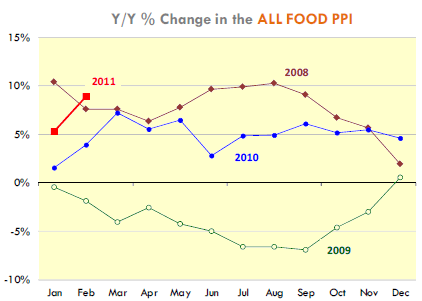



CME: Producer Price Indices for Pork, Beef, Broilers
US - Cattle futures were sharply lower again on Wednesday although the action was somewhat more positive in overnight trading, write Steve Meyer and Len Steiner.The nearby April contract closed at $110.5/cwt., down more than 700 points since the Japan earthquake and the ensuing mayhem. The action in the hog complex was a bit more positive although prices remain well below the peaks established in mid February. The negativity in the cattle complex appeared to be closely linked with the situation in equity markets and speculation that as the Japan situation spirals out of control, the US economy could be negatively affected. In such a scenario, beef is seen as more vulnerable than pork and chicken since consumers would opt for less expensive protein products. Then there is the issue of US beef shipments to Japan and other Asian countries.

The consequences of a
full blown nuclear catastrophe in Japan are hard to imagine and could
deeply affect the entire region. In that context, high value protein is also
seen as particularly vulnerable and market participants raced to reduce
some of their risk exposure, causing a number of live and feeder cattle futures
contracts to decline the daily permissible limit of 300 points for a second
consecutive day. For now, livestock and agricultural commodity markets
remain in a state of suspended animation, uncertain what to make of
the Japan situation. Just as we saw with the oil spill in the Gulf of Mexico,
people are coming to grips with the limits of human capabilities and real
life often follows a different path than a Hollywood flick.
Some may find little surprise in the fact that traders have been
anxious to dump cattle contracts at a time of such heightened anxiety. After
all, beef prices have been rising rapidly on account of an improving economy
both in the US and abroad. The latest numbers out of the US Bureau of
Labor Statistics showed that the beef and veal component in the Producer
Price Index (PPI) rose 20 per cent compared to year ago levels in February, outpacing
pork and chicken. The PPI index for pork products was up 14 per cent from a
year ago while the index tracking whole broiler prices actually declined 7 per cent from last year. Overall, the PPI index tracking all
food products at various stages of processing rose 9 per cent compared to the previous year and the largest year over year increase
since the summer of 2008.

Higher producer input costs will eventually impact the costs to the US consumer. The transmission of higher costs downstream to the consumer is no immediate and the magnitude is generally smaller. This is because raw material input costs make up only a portion of the finished good price. The question on the minds of many people going into 2011 was whether producers would be able to pass along the higher input prices and with a growing economy, the common answer was: probably yes. All that has come into question considering the unfolding events in Japan and the deep anxiety they have created worldwide. As a Wall Street Journal recently noted: “Japan trumps everyone for everyone right now.”











